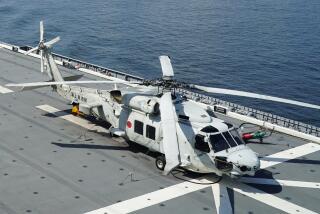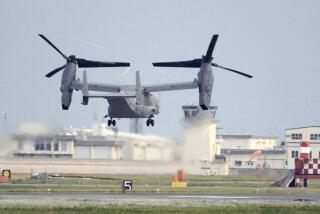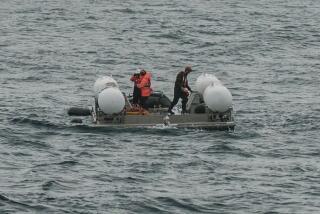Navy Says Civilians Could Have Hindered Sub Crew
- Share via
HONOLULU — The Coast Guard said Wednesday that it plans to end its search tonight for nine people missing after a U.S. nuclear submarine collided with a Japanese trawler, as Navy officials investigated whether 16 civilians aboard the sub may have distracted its crew before the crash.
While most of the survivors from the Ehime Maru flew home Wednesday, Navy officials also acknowledged that their probe could lead to criminal charges against one or more crew members of the attack sub Greeneville.
But so far, they said, investigators have no proof of criminal wrongdoing aboard the attack submarine that would have led to the Friday crash. The Greeneville’s captain, Cmdr. Scott Waddle, was reassigned to a desk job pending completion of an investigation into the tragedy.
Meanwhile, Japanese officials who have been in Honolulu since the collision expressed outrage Wednesday over the latest developments, saying they could not fathom how civilians could be allowed on board an active sub.
The accident occurred when the 360-foot-long Greeneville conducted a rapid ascent, called an “emergency blow,” in the seas several miles south of Diamond Head. The crew was unaware that the 190-foot trawler, filled with teenagers learning commercial fishing, had drifted overhead. The sub’s stern split the Ehime Maru.
The vessel sank within minutes, and investigators believe it carried some of the passengers and crew 1,800 feet down with it.
In the six days since the collision, Coast Guard and Navy ships, planes and helicopters have spent more than 250 hours searching 21,000 square miles of ocean for any sign of life.
Twenty-six crew members and students were rescued shortly after the collision. But four 17-year-old students, three crew members and two teachers were lost at sea and are presumed dead.
Coast Guard Rear Adm. Joseph J. McClelland Jr. said that he had anticipated ending the search Wednesday evening. But “in order to ensure that there is clear understanding among the families and with the [Japanese] government, I am extending [the search] into tomorrow to ensure that the communication is complete.”
Navy officials said that they planned to begin searching today for the wreckage of the vessel on the sea floor to determine whether salvage operations can begin.
Navy officials disclosed Tuesday that two civilians--who were described as being among a group of Hawaii businesspeople and community leaders along for a regular “orientation tour”--had been sitting in key posts in the sub’s control room when the vessels collided.
Officials said visitors routinely are allowed to sit in the helm and the ballast-control seats to give them the sensation of guiding a nuclear-powered sub. They also said emergency surfacing drills, which rocket submarines skyward, are a regular part of orientation tours.
Speaking with reporters late Tuesday night, Navy Capt. Tom Kyle of the Pacific Fleet’s submarine forces said that “it would make no difference” to the safety of a trip if civilians sat in the helm or ballast positions.
“It’s not germane to the incident,” Kyle said, referring to the crash. “A qualified person would be in total control of that watch station, regardless of whether the civilian or non-qualified person was there or not.”
Nevertheless, Navy officials said that they cannot entirely rule out the possibility that the presence of the visitors might have distracted crew members.
Meanwhile, the commander of the Navy’s Pacific Fleet told a Senate panel Wednesday that he was baffled about why the sub’s skipper had failed to see the large trawler floating above it.
Adm. Thomas Fargo told the Senate Armed Services Committee in a closed-door session that it was difficult to understand how, after using sonar and a periscope to scan the surface for miles around, Cmdr. Waddle had failed to notice the 190-foot vessel, a defense official said.
In Fargo’s mind, “the question was, how did they not see it,” said the defense official, who asked to remain unidentified. “It’s a question we’ve all been asking ourselves.”
The official said that, after more than five days of investigation, the mystery has not lessened.
It appears that both the sonar check and the periscope check were carried out competently. The skipper and the officer of the deck both examined the surface through the periscope.
It appears that the submarine did not linger underwater so long after the scans that the trawler could have slipped unnoticed into the way.
The guidelines say the sub should surface within a little more than 10 minutes of conducting these examinations; in this case, the Greeneville surfaced after slightly more than five minutes, the official said.
Yoshitaka Sakurada, Japan’s parliamentary secretary for foreign affairs, demanded an explanation Wednesday from U.S. officials of how civilians could have been at the controls of the submarine during its disastrous ascent.
“We in Japan cannot understand why a civilian was at the controls,” said a Japanese government delegate present at a meeting between Sakurada and Lt. Gen. Thomas R. Case, deputy commander in chief of the U.S. Pacific Command.
“We also don’t understand why the United States didn’t tell us this earlier,” the Japanese official said. “We only found out yesterday. That’s not acceptable.”
Case replied that he understood their anger but that he only found out about the civilians’ presence himself Tuesday. He pledged to do his best to get Japanese authorities as much information as possible.
Although Sakurada pressed Case to reveal where the civilians were sitting and whether it was against the rules for them to be at the controls during an emergency drill, he was unable to answer, the Japanese source said. “The fact that civilians were in the submarine was not necessarily unusual. But we don’t know how their presence affected the accident, and we are going to look into that,” Case was quoted as saying.
Last year, Navy submarines in Hawaii sailed on 13 orientation trips, carrying a total of 213 guests, said John Hammerschmidt, a member of the National Transportation Safety Board here for the Greeneville investigation.
There were 13 similar trips sailing from San Diego and carrying 323 visitors during the same period and 24 such submarine trips carrying 793 visitors from Naval Submarine Base, Bangor, in Washington state, he said.
Speaking with reporters late Tuesday, Hammerschmidt said that he had requested the data from the Navy as part of the NTSB’s probe into the collision.
He also read from a May 10 memo to Navy personnel describing the need for greater outreach to the public about the military mission--with the goal of “reconnecting America with its military.”
Among the major questions to be dealt with during the NTSB investigation are whether the Greeneville’s detection equipment--sonar, periscope and the like--was operating properly and could have sensed the Ehime Maru.
NTSB investigators Tuesday began testing the submarine’s sonar systems, Hammerschmidt said, an effort that could take up to a week. They also checked out the primary periscope, which “tested OK today, optically,” he said.
While the NTSB had hoped to gain clues to the accident from recording equipment in the submarine’s sonar and periscope, Hammerschmidt said, “the general practice is not to record, and we are informed that there are no videotapes of the time of the accident.”
No sonar tapes were recorded either, Hammerschmidt said. Because the Greeneville’s computers may hold some archived sonar information that could paint a picture of what the submarine crew should have seen, computer experts will be aiding the investigation.
The direction of the Navy’s investigation is in the hands of Rear Adm. Charles Griffiths Jr., commander of Submarine Group Nine, which is based at Bangor. He has been in Hawaii since last weekend.
*
La Ganga reported from Honolulu and Richter from Washington. Times special correspondent Susan Essoyan in Honolulu contributed to this story.
More to Read
Sign up for Essential California
The most important California stories and recommendations in your inbox every morning.
You may occasionally receive promotional content from the Los Angeles Times.















